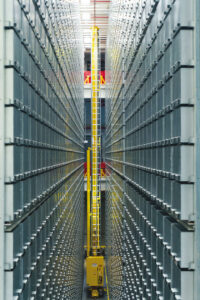Robotics Leads the Way for ASRS
New technology is improving ease of use, scalability and flexibility.
By: Jane Marsh, Contributor
Robotics can help businesses design flexible, user-friendly automated storage and retrieval systems (ASRS) that maximize efficiency and return on investment (ROI). In fact, robotic ASRS are showing strong market growth, and offer several key benefits.
What’s driving this growth?
Adoption of robotics for ASRS is on the rise. This technology has advanced significantly over recent years, making it more capable, accessible and affordable.
The global market for ASRS is expected to reach $18.12 billion by 2032 with a 7.8% compound annual growth rate. That means the market will more than double in size from 2022. Robotic ASRS are one of the fastest-growing market categories, and the automotive industry is among the largest adopters of ASRS technology.
In addition to automotives, logistics remains one of the primary industries using ASRS and robotics in the workplace. These systems have become even more important since 2020 due to an ongoing shortage of warehouse space. Warehouse rental rates are also on the rise across the U.S. as demand remains high and supply remains historically low.
As a result, logistics, manufacturing and other industrial sectors have to maximize efficient storage to make the most of the limited space they have. Robotic ASR systems are emerging as a top solution for this need.
What makes robotics ideal?

Overly complicated systems and rigid design principles can make ASRS less effective than it could be. © Konstantin L – stock.
adobe.com
There are several key benefits to adopting robotics for ASRS technology, particularly in fields like logistics and manufacturing.
Ease of use
Ease of use is a top priority for any business developing a digital transformation strategy. While ASRS is a great technology to implement in a digital transformation, overly complicated systems and rigid design principles can hinder success. Robots are often familiar to employees today and tend to have user-friendly interfaces.
For instance, some robotic ASRS use autonomous mobile robots that don’t require programming to operate. The AMRs use a simplified code-free software platform instead, which is designed to be easy for employees to work with.
High usability is vital to the successful implementation of ASRS because it directly impacts ROI. If employees are struggling to understand how an ASRS works, the system’s performance will not reach its full potential. This results in a lower ROI and decreased employee productivity.
Robots are an easy solution because they are a familiar, intuitive technology. Employees already have a basic understanding of how a robot works. This allows them to approach a robot-based ASRS with minimal confusion.
A user-friendly, code-free interface is particularly helpful, but this is an increasingly popular feature in the market today. Developers know employees need something clear and simple to work with. More and more new ASRS robots are emerging on the market to meet that need.
Scalability
One of the most convenient benefits of a robotic ASRS is high scalability. The modular nature of these systems minimizes the complexity of scaling up or down. Businesses can add or remove individual robots to customize the size and functionality of their ASRS as needed.
This reduces the stress and expense often associated with scaling up automated systems. Businesses can simply buy or sell individual robots to adjust course. Plus, the variety of robots on the market today makes robotic ASRS highly customizable.
Flexibility
Studies show that strategic use of AMRs in the workplace can increase flexibility while lowering costs. Flexibility is invaluable in logistics, manufacturing and other industrial sectors. The ability to adapt a certain robot to fit new needs as they arise allows businesses to maximize the ROI of every robot they invest in.
With an ASRS, the system can grow and change in a wide variety of ways. Businesses aren’t limited to rigid pre-designed functions and strategies. They can use a mix of robots in their system or change how they use a certain type of robot if they need to.
A high degree of flexibility empowers businesses to design a unique ASRS that works for them. One-size-fits-all solutions are no longer the only option on the market. With robotics, businesses can maximize the value and performance of their ASRS by building an adaptive, customized system.
The potential of robotic ASRS
Businesses can use robots to build an innovative, personalized ASRS. Robotics is particularly well-suited for this application. Many employees today are already familiar with robots, allowing for easier training and integration. Robots also offer a high level of flexibility that empowers businesses to maximize the ROI of their ASRS through customization and adaptability. WMHS
Jane Marsh covers topics in green technology and manufacturing. She also works as the editor-in-chief of environment.co, which takes complex climate science and green technology topics and breaks them down in a way the everyday person can understand and feel empowered to make better choices for themselves and the planet.




